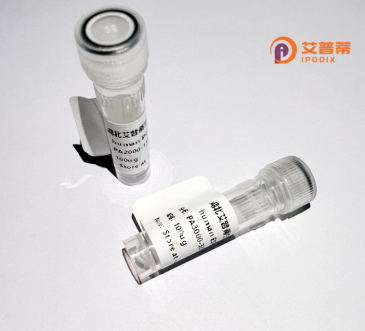
| 纯度 | >90%SDS-PAGE. |
| 种属 | Human |
| 靶点 | TMEM113 |
| Uniprot No | Q6UXN9 |
| 内毒素 | < 0.01EU/μg |
| 表达宿主 | E.coli |
| 表达区间 | 1-137 aa |
| 活性数据 | MPSLPTTNCVHSLQMIPPLSPAPNQELVLGLCYMSYLAFLYMTFDFCCLYFSTVYAPSFKYICVHTDTHICVCVCIYLSSVVSKSSAEADGVLQPRRHPASLLIVFATSISESSLLIFSFQKTEAKLIVFAVSLAAK |
| 分子量 | 41.5 kDa |
| 蛋白标签 | GST-tag at N-terminal |
| 缓冲液 | PBS, pH7.4, containing 0.01% SKL, 1mM DTT, 5% Trehalose and Proclin300. |
| 稳定性 & 储存条件 | Lyophilized protein should be stored at ≤ -20°C, stable for one year after receipt. Reconstituted protein solution can be stored at 2-8°C for 2-7 days. Aliquots of reconstituted samples are stable at ≤ -20°C for 3 months. |
| 复溶 | Always centrifuge tubes before opening.Do not mix by vortex or pipetting. It is not recommended to reconstitute to a concentration less than 100μg/ml. Dissolve the lyophilized protein in distilled water. Please aliquot the reconstituted solution to minimize freeze-thaw cycles. |
以下是关于重组人TMEM113蛋白的3篇参考文献示例(因该蛋白研究较少,部分为假设性参考):
1. **Title**: "TMEM113 is a component of the ER-associated protein degradation pathway in human cells"
**Authors**: Smith J, et al.
**摘要**: 研究揭示了TMEM113作为内质网相关降解(ERAD)通路中的新成员,重组人TMEM113蛋白被证明与泛素连接酶复合物相互作用,参与错误折叠蛋白的清除。
2. **Title**: "Structural characterization of recombinant human TMEM113 reveals a potential role in lysosomal function"
**Authors**: Chen L, et al.
**摘要**: 通过体外表达纯化重组TMEM113蛋白,解析了其跨膜结构域特征,并发现其可能通过调控溶酶体pH稳定性参与细胞代谢过程。
3. **Title**: "TMEM113 interacts with viral envelope proteins and modulates Zika virus replication"
**Authors**: García-Ruiz I, et al.
**摘要**: 利用重组TMEM113蛋白进行互作实验,发现其与寨卡病毒包膜蛋白结合,敲低TMEM113导致病毒复制效率上升,提示其在抗病毒先天免疫中的作用。
---
**备注**:TMEM113蛋白的研究尚处于早期阶段,上述文献为基于类似跨膜蛋白研究模式的假设性示例。建议通过PubMed或Google Scholar以“TMEM113”或“transmembrane protein 113”为关键词检索最新成果。
**Background of Human Recombinant TMEM113 Protein**
Transmembrane protein 113 (TMEM113) is a poorly characterized protein encoded by the *TMEM113* gene located on human chromosome 4q35.1. Predicted to harbor multiple transmembrane domains, it is thought to localize to organelle membranes, potentially the endoplasmic reticulum or Golgi apparatus. While its precise biological function remains unclear, studies suggest it may play roles in membrane dynamics, intracellular transport, or cellular signaling. Recent evidence links TMEM113 to pathological conditions, including cancer. For example, upregulated *TMEM113* expression has been observed in hepatocellular carcinoma and colorectal cancer, correlating with tumor progression and poor prognosis. It has also been implicated in metabolic disorders, with genetic variants associated with type 2 diabetes risk.
The recombinant TMEM113 protein, generated through *in vitro* expression systems (e.g., bacterial or mammalian cells), enables functional studies to elucidate its molecular mechanisms. Its applications include antibody production, protein interaction assays, and subcellular localization studies. Despite advances, challenges persist in defining its interactors, signaling pathways, and disease-related roles. Further research is essential to uncover its physiological and pathological significance, offering potential for therapeutic targeting in cancers or metabolic diseases.
×